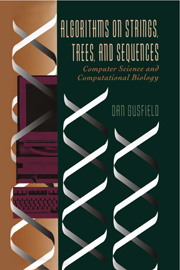Book contents
- Frontmatter
- Contents
- Preface
- I Exact String Matching: The Fundamental String Problem
- II Suffix Trees and Their Uses
- 5 Introduction to Suffix Trees
- 6 Linear-Time Construction of Suffix Trees
- 7 First Applications of Suffix Trees
- 8 Constant-Time Lowest Common Ancestor Retrieval
- 9 More Applications of Suffix Trees
- III Inexact Matching, Sequence Alignment, Dynamic Programming
- IV Currents, Cousins, and Cameos
- Epilogue – where next?
- Bibliography
- Glossary
- Index
8 - Constant-Time Lowest Common Ancestor Retrieval
from II - Suffix Trees and Their Uses
Published online by Cambridge University Press: 23 June 2010
- Frontmatter
- Contents
- Preface
- I Exact String Matching: The Fundamental String Problem
- II Suffix Trees and Their Uses
- 5 Introduction to Suffix Trees
- 6 Linear-Time Construction of Suffix Trees
- 7 First Applications of Suffix Trees
- 8 Constant-Time Lowest Common Ancestor Retrieval
- 9 More Applications of Suffix Trees
- III Inexact Matching, Sequence Alignment, Dynamic Programming
- IV Currents, Cousins, and Cameos
- Epilogue – where next?
- Bibliography
- Glossary
- Index
Summary
Introduction
We now begin the discussion of an amazing result that greatly extends the usefulness of suffix trees (in addition to many other applications).
Definition In a rooted tree T, a node u is an ancestor of a node v if u is on the unique path from the root to v. With this definition a node is an ancestor of itself. A proper ancestor of v refers to an ancestor that is not v.
Definition In a rooted tree T, the lowest common ancestor (lca) of two nodes x and y is the deepest node in T that is an ancestor of both x and y.
For example, in Figure 8.1 the lca of nodes 6 and 10 is node 5 while the lca of 6 and 3 is 1.
The amazing result is that after a linear amount of preprocessing of a rooted tree, any two nodes can then be specified and their lowest common ancestor found in constant time. That is, a rooted tree with n nodes is first preprocessed in O(n) time, and thereafter any lowest common ancestor query takes only constant time to solve, independent of n. Without preprocessing, the best worst-case time bound for a single query is Θ(n), so this is a most surprising and useful result. The lca result was first obtained by Harel and Tarjan [214] and later simplified by Schieber and Vishkin [393]. The exposition here is based on the later approach.
- Type
- Chapter
- Information
- Algorithms on Strings, Trees and SequencesComputer Science and Computational Biology, pp. 181 - 195Publisher: Cambridge University PressPrint publication year: 1997



